Preparation of a High-Performance Porous Ceramic Membrane by a Two-Step Coating Method and One-Step Sintering
Abstract
1. Introduction
2. Materials and Methods
2.1. Preparation of Membranes
2.2. Characterization of the Membranes
3. Results and Discussion
3.1. Effect of the Preparation Process on the Properties of the Ceramic Membrane
3.2. Effect of the Solid Content on the Properties of the Ceramic Membrane
3.3. Effect of Coating Time on the Properties of the Ceramic Membrane
3.4. Permeating Flux of the Ceramic Membrane
4. Conclusions
Author Contributions
Funding
Acknowledgments
Conflicts of Interest
References
- Sarkar, S.; Bandyopadhyay, S.; Larbot, A.; Cerneaux, S. New clay–alumina porous capillary supports for filtration application. J. Membr. Sci. 2018, 392, 130–136. [Google Scholar] [CrossRef]
- Shkrabina, R.A.; Boneckamp, B.; Pex, P.; Veringa, H.; Ismagilov, Z. Porous structure of alumina ceramic support for gas separation membranes, II. Study of porous structure of ceramic composition. React. Kinet. Catal. Lett. 1995, 54, 193–201. [Google Scholar] [CrossRef]
- Dong, Y.; Chen, S.; Zhang, X.; Yang, J.; Liu, X.; Meng, G. Fabrication and characterization of low cost tubular mineral-based ceramic membranes for micro-filtration from natural zeolite. J. Membr. Sci. 2006, 281, 592–599. [Google Scholar] [CrossRef]
- Bao, Q.; Dong, W.; Zhou, J.; Wang, Y.; Liu, Y. Effects of pore former on properties of alumina porous ceramic for application in micro-filtration membrane supports. Key Eng. Mater. 2015, 655, 97–102. [Google Scholar] [CrossRef]
- Wang, F.; Ye, J.; He, G.; Liu, G.; Xie, Z.; Li, J. Preparation and characterization of porous MgAl2O4 spinel ceramic supports from bauxite and magnesite. Ceram. Int. 2015, 41, 7374–7380. [Google Scholar] [CrossRef]
- Hubadillah, S.; Othman, M.; Matsuura, T. Fabrications and applications of low cost ceramic membrane from kaolin: A comprehensive review. Ceram. Int. 2018, 44, 4538–4560. [Google Scholar] [CrossRef]
- Yin, X.; Guan, K.; Gao, P. A preparation method for the highly permeable ceramic microfiltration membrane—Precursor film firing method. RSC Adv. 2018, 8, 2906–2914. [Google Scholar] [CrossRef]
- Guo, H.; Li, W.; Ye, F. Low-cost porous mullite ceramic membrane supports fabricated from kyanite by casting and reaction sintering. Ceram. Int. 2016, 42, 4819–4826. [Google Scholar] [CrossRef]
- Bruggen, B.; Vandecasteele, C.; Gestel, T. A review of pressure-driven membrane processes in wastewater treatment and drinking water production. Environ. Prog. Sustain. 2010, 22, 46–56. [Google Scholar] [CrossRef]
- Yanagishita, H.; Kitamoto, D.; Haraya, K. Separation performance of polyimide composite membrane prepared by dip coating process. J. Membr. Sci. 2001, 188, 165–172. [Google Scholar] [CrossRef]
- Ding, X.; Fan, Y.; Xu, N. Modeling and control of ceramic membrane thickness during dip-coating process. J. Chem. Ind. Eng. 2006, 57, 1003–1008. (In Chinese) [Google Scholar] [CrossRef]
- Yan, H.; Lu, X.; Wu, C. Fabrication of a super-hydrophobic polyvinylidene fluoride hollow fiber membrane using a particle coating process. J. Membr. Sci. 2017, 533, 130–140. [Google Scholar] [CrossRef]
- Chang, Q.; Yang, Y.; Zhang, X.; Wang, Y.; Zhou, J.; Wang, X.; Cerneaux, S.; Zhu, L.; Dong, Y. Effect of particle size distribution of raw powders on pore size distribution and bending strength of Al2O3, microfiltration membrane supports. J. Eur. Ceram. Soc. 2014, 34, 3819–3825. [Google Scholar] [CrossRef]
- Liu, Y.; Zhu, W.; Guan, K. Preparation of high permeable alumina ceramic membrane with good separation performance via UV curing technique. RSC Adv. 2018, 8, 13567–13577. [Google Scholar] [CrossRef]
- Sun, C.; Zhang, J.; Jiang, W. Study on preparation of ultrafine separation membrane on porous alumina supporters. Inorg. Chem. Ind. 2010, 42, 17–20. (In Chinese) [Google Scholar] [CrossRef]
- Samei, M.; Mohammadi, T.; Asadi, A. Tubular composite PVA ceramic supported membrane for bio-ethanol production. Chem. Eng. Res. Des. 2013, 91, 2703–2712. [Google Scholar] [CrossRef]
- Zhu, J.; Fan, Y.; Xu, N. Modified dip-coating method for preparation of pinhole-free ceramic membranes. J. Membr. Sci. 2011, 367, 14–20. [Google Scholar] [CrossRef]
- Chen, X.; Lin, Y.; Lu, Y. A facile nanoparticle doping sol–gel method for the fabrication of defect-free nanoporous ceramic membranes. Colloid Interface Sci. Commun. 2015, 5, 12–15. [Google Scholar] [CrossRef]
- Zou, D.; Qiu, M.; Chen, X.; Fan, Y. One-step preparation of high-performance bi-layer α-alumina ultrafiltration membranes via co-sintering process. J. Membr. Sci. 2017, 524, 141–150. [Google Scholar] [CrossRef]
- Bayat, A.; Mahdavi, H.; Kazemimoghaddam, M. Preparation and characterization of γ-alumina ceramic ultrafiltration membranes for pretreatment of oily wastewater. Desalin. Water Treat. 2016, 57, 1–11. [Google Scholar] [CrossRef]
- Islam, M.; Stoicheva, R. An investigation on the capillary viscosities of some hydrophilic fluids permeating through a poly(vinyl chloride) membrane. J. Membr. Sci. 1994, 92, 209–215. [Google Scholar] [CrossRef]
- Choudhury, P.; Ranawat, M.; Chauhan, C. Asymmetric membrane capsule for osmotic delivery of flurbiprofen. Acta Pharm. 2007, 57, 343–350. [Google Scholar] [CrossRef] [PubMed]
- Levich, V. Physicochemical Hydrodynamics. Phys. Today 1963, 16, 75. [Google Scholar] [CrossRef]
- Yang, Y.; Chang, Q.; Hu, Z.; Zhang, X. A Comparative Study on the Addition Methods of TiO2 Sintering Aid to the Properties of Porous Alumina Membrane Support. Membranes 2018, 8, 49. [Google Scholar] [CrossRef] [PubMed]
- Bissett, H.; Zah, J.; Krieg, H. Manufacture and optimization of tubular ceramic membrane supports. Powder Technol. 2008, 181, 57–66. [Google Scholar] [CrossRef]




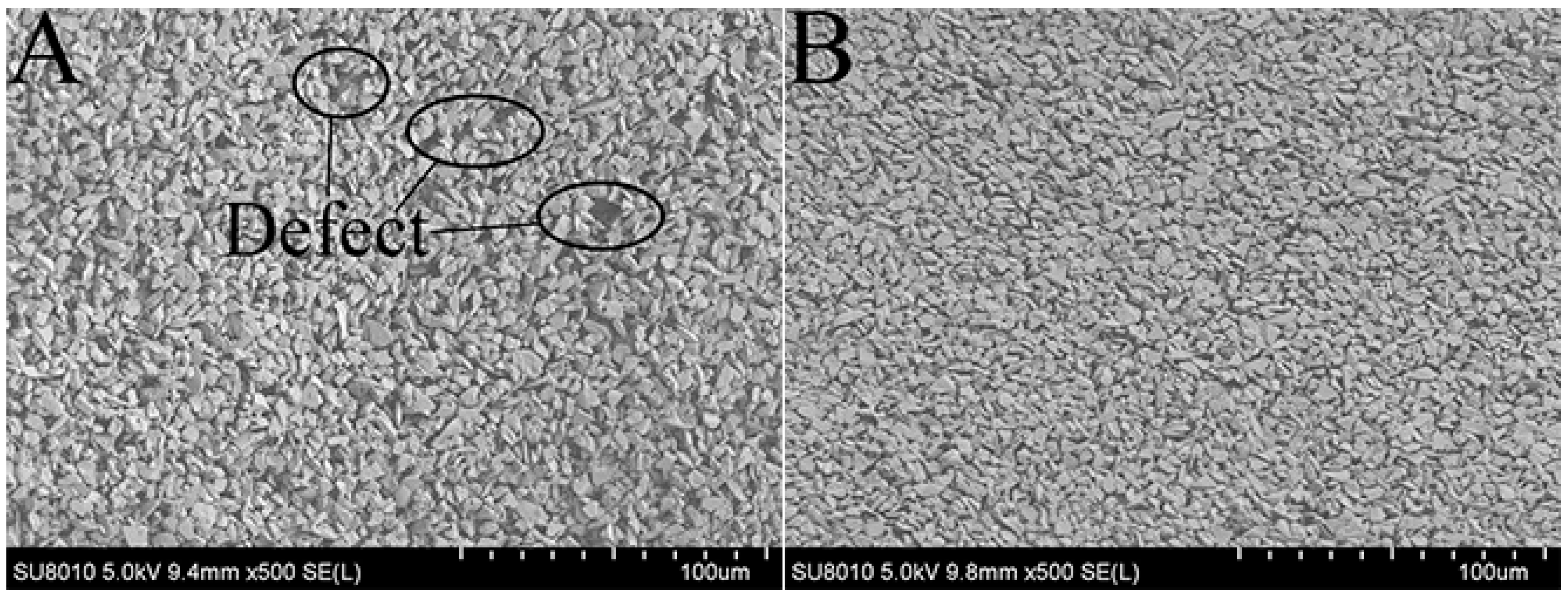
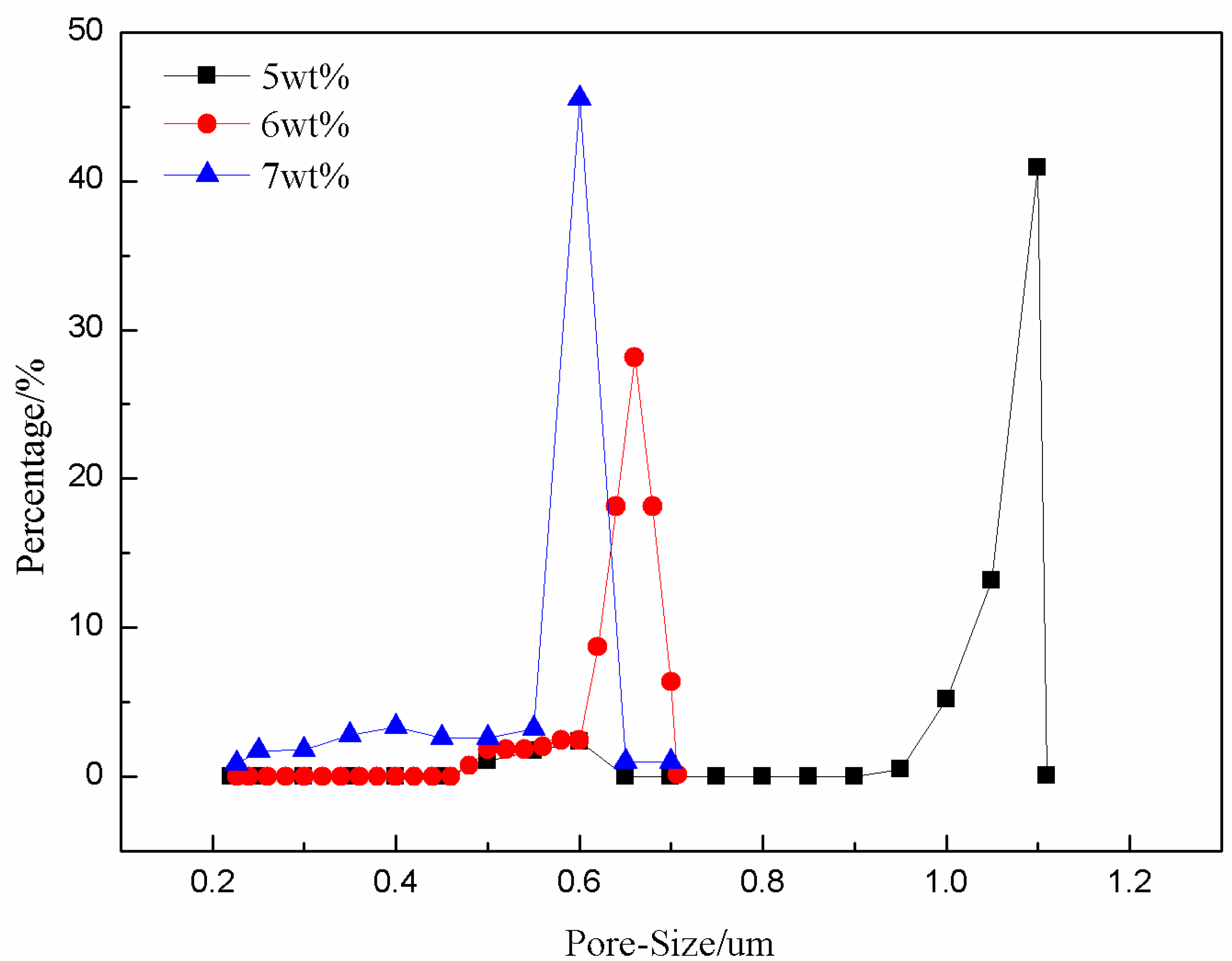
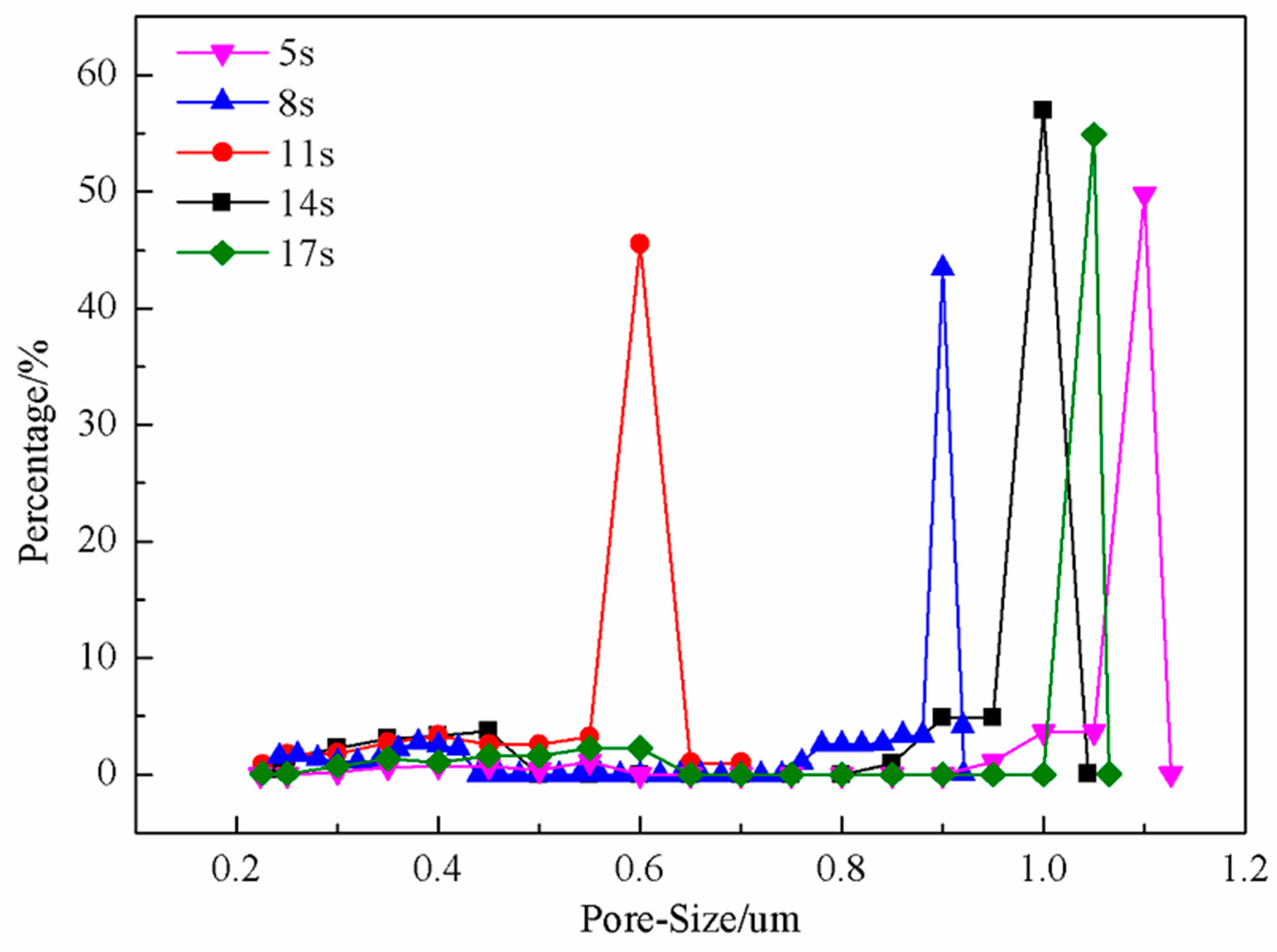
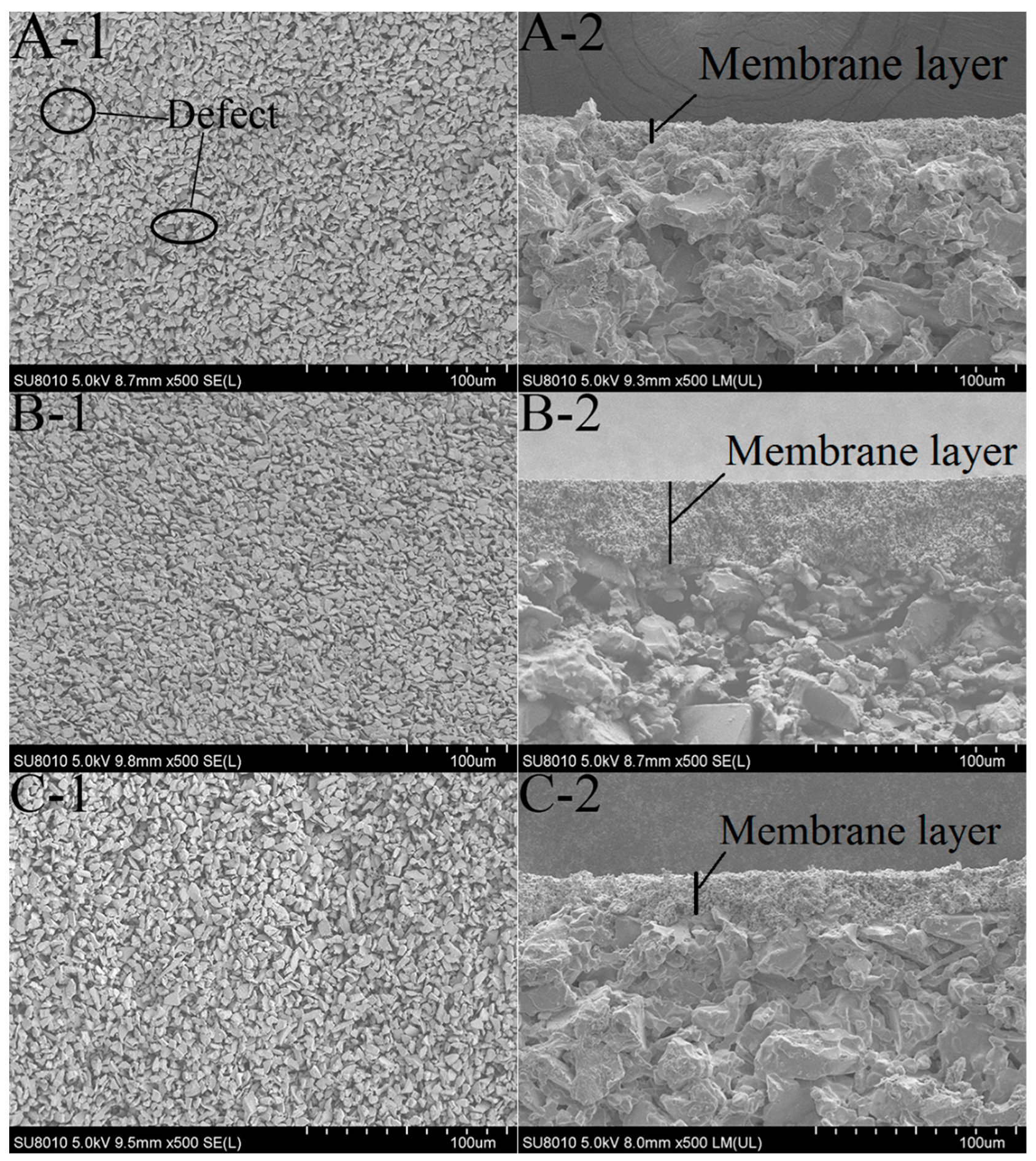
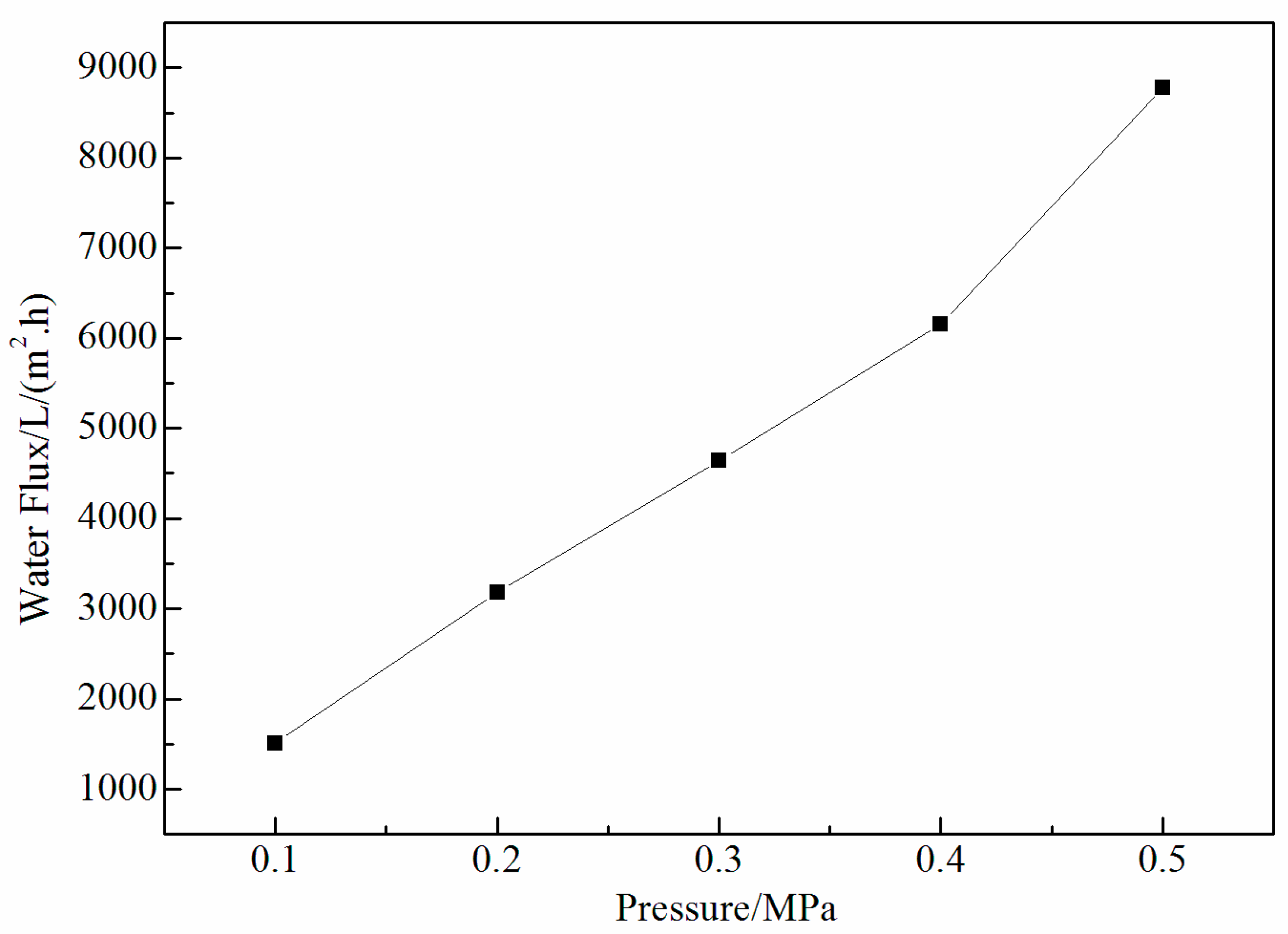
| Coating Process | Advantages and Disadvantages | Authors and Literature |
|---|---|---|
| Dip-coating process. The support is placed vertically, and the suspension is driven by a pump to maintain the flow inside the support’s inner cavity at a certain flow velocity, One-step coating and sintering is used. | It is easy to operate with high efficiency, but the performance of the ceramic membranes depends on the pump power and the support properties. However, this leads to different parts having uneven membrane thicknesses. | Zhu, J. [17]; Fan, Y.; Xu, N. “Modified dip-coating method for preparation of pinhole-free ceramic membranes” |
| Dip-coating process, two-step coating and one-step sintering. A layer of organic material is coated, and then the separate layer of slurry is coated. | Low cost and high efficiency are the advantages of the process, but the viscosity of the organics and the sintering system have a great influence on the bonding properties of the ceramic membranes. It is much harder to industrialize. | Chen, X. [18]; Lin, Y.; Lu, Y. “A facile nanoparticle doping sol–gel method for the fabrication of defect-free nanoporous ceramic membranes” |
| Dip-coating process, boehmite sol mixed with alumina particles as the membrane slurry, two-step coating and one-step sintering. | The process is highly efficient and has a low cost. However, the stability of the slurry is difficult to control, and the process is complex. It is easy to identify membrane defects, but hard to industrialize. | Zou, D. [19]; Qiu, M.; Chen, X.; Fan, Y. “One-step preparation of high-performance bi-layer α-alumina ultrafiltration membranes via co-sintering process” |
| Dip-coating process, sol-gel method, two-step coating, and two-step sintering. | The performance of the membrane is high, and the preparation has a high cost. It has low efficiency, and the process is complex. | Bayat, A. [20]; Mahdavi, H.; Kazemimoghaddam, M. “Preparation and characterization of γ-alumina ceramic ultrafiltration membranes for pretreatment of oily wastewater” |
© 2018 by the authors. Licensee MDPI, Basel, Switzerland. This article is an open access article distributed under the terms and conditions of the Creative Commons Attribution (CC BY) license (http://creativecommons.org/licenses/by/4.0/).
Share and Cite
Hu, Z.; Yang, Y.; Chang, Q.; Liu, F.; Wang, Y.; Rao, J. Preparation of a High-Performance Porous Ceramic Membrane by a Two-Step Coating Method and One-Step Sintering. Appl. Sci. 2019, 9, 52. https://doi.org/10.3390/app9010052
Hu Z, Yang Y, Chang Q, Liu F, Wang Y, Rao J. Preparation of a High-Performance Porous Ceramic Membrane by a Two-Step Coating Method and One-Step Sintering. Applied Sciences. 2019; 9(1):52. https://doi.org/10.3390/app9010052
Chicago/Turabian StyleHu, Zhiwen, Yulong Yang, Qibing Chang, Fengli Liu, Yongqing Wang, and Jinfeng Rao. 2019. "Preparation of a High-Performance Porous Ceramic Membrane by a Two-Step Coating Method and One-Step Sintering" Applied Sciences 9, no. 1: 52. https://doi.org/10.3390/app9010052
APA StyleHu, Z., Yang, Y., Chang, Q., Liu, F., Wang, Y., & Rao, J. (2019). Preparation of a High-Performance Porous Ceramic Membrane by a Two-Step Coating Method and One-Step Sintering. Applied Sciences, 9(1), 52. https://doi.org/10.3390/app9010052





